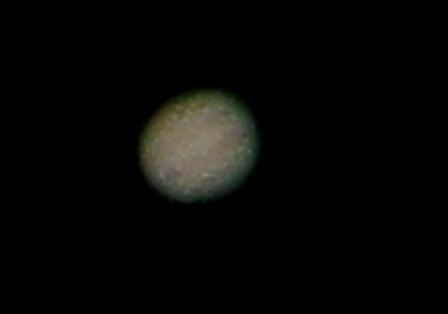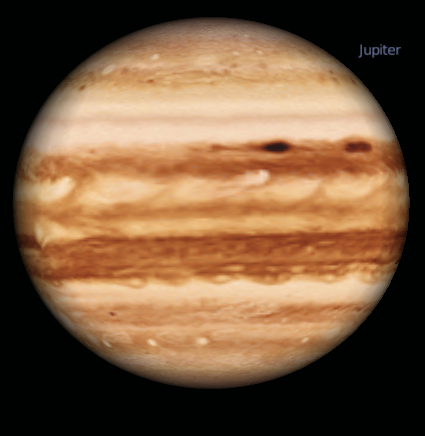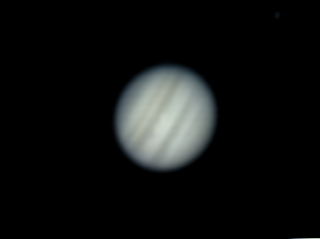Jupiter
 This afocal picture of Jupiter was taken from the 'Ewelme
Observatory' on 28th August 2009 at 21:50 GMT, which is a very
sensible time for an armchair astronomer! 'Afocal' means that it was
taken using a camera (Canon G9 - 12Mpx) with a fixed lens, pointing
directly into the eyepiece (25mm Plössl) of a reflecting telescope
(re-constructed 10" [250mm] Dobsonian). This is opposed to using a
CCD (charge Couple Device) or DSLR (Digital Single Lens Reflex)
camera with the lens removed directly exposing the CCD light sensor.
The object of this exercise, during a short clear period where
Jupiter could be easily seen in the southern sky during late
evening, was to record a picture of Jupiter's 4 major moons known
as the Galilean satellites (she has at least 16!). The problem on
previous occasions was that although it had been easy enough to
observe Jupiter's moons through various eyepieces and Barlows, to
actually photograph them was proving quite difficult. One reason is
that the speedy orbit of each moon means they are often eclipsed or
are transiting in front of Jupiter. Another reason is that in
photographing this combination, the contrast between the brightness
of the planet and the dimness of the moons means that the settings
of aperture, shutter speed and equivalent film speed (ISO), needs
to be experimented with, and it cannot really be ascertained until
another day when the pictures can be studied using a computer,
whether a particular setting has been successful or not. The fact
is, on one night, the brightness and lens glare of Jupiter seemed to
blot out one of the moons - Io. One idea was to use the only filter
I possessed - a Moon filter to try to reduce this. Whilst this
didn't do a great deal to help improve the moons shot, I discovered
to my amazement that when digitally zooming in on Jupiter using the
computer the next day, rather than just seeing a bright featureless
disc, the familiar colour contrast banding and eddies (storms?)
began to appear. I have established that at this particular moment
Jupiter's 'Great Red Spot' was not visible, which with this gigantic
gas planet's rotational period of just under 10 hours was just
unlucky. This feature would have undoubtedly provided a little more
contrast to the subtle colour shading obtained. However, although
this isn't up to Hubble or fly-by probe standards, I'm extremely
pleased at having been able to capture this image at such a sociable
time. Just think what I could do next time around with another
choice of filter and more experiments with shutter timings etc.!
Maybe to achieve something like this? (off the Internet).
This afocal picture of Jupiter was taken from the 'Ewelme
Observatory' on 28th August 2009 at 21:50 GMT, which is a very
sensible time for an armchair astronomer! 'Afocal' means that it was
taken using a camera (Canon G9 - 12Mpx) with a fixed lens, pointing
directly into the eyepiece (25mm Plössl) of a reflecting telescope
(re-constructed 10" [250mm] Dobsonian). This is opposed to using a
CCD (charge Couple Device) or DSLR (Digital Single Lens Reflex)
camera with the lens removed directly exposing the CCD light sensor.
The object of this exercise, during a short clear period where
Jupiter could be easily seen in the southern sky during late
evening, was to record a picture of Jupiter's 4 major moons known
as the Galilean satellites (she has at least 16!). The problem on
previous occasions was that although it had been easy enough to
observe Jupiter's moons through various eyepieces and Barlows, to
actually photograph them was proving quite difficult. One reason is
that the speedy orbit of each moon means they are often eclipsed or
are transiting in front of Jupiter. Another reason is that in
photographing this combination, the contrast between the brightness
of the planet and the dimness of the moons means that the settings
of aperture, shutter speed and equivalent film speed (ISO), needs
to be experimented with, and it cannot really be ascertained until
another day when the pictures can be studied using a computer,
whether a particular setting has been successful or not. The fact
is, on one night, the brightness and lens glare of Jupiter seemed to
blot out one of the moons - Io. One idea was to use the only filter
I possessed - a Moon filter to try to reduce this. Whilst this
didn't do a great deal to help improve the moons shot, I discovered
to my amazement that when digitally zooming in on Jupiter using the
computer the next day, rather than just seeing a bright featureless
disc, the familiar colour contrast banding and eddies (storms?)
began to appear. I have established that at this particular moment
Jupiter's 'Great Red Spot' was not visible, which with this gigantic
gas planet's rotational period of just under 10 hours was just
unlucky. This feature would have undoubtedly provided a little more
contrast to the subtle colour shading obtained. However, although
this isn't up to Hubble or fly-by probe standards, I'm extremely
pleased at having been able to capture this image at such a sociable
time. Just think what I could do next time around with another
choice of filter and more experiments with shutter timings etc.!
Maybe to achieve something like this? (off the Internet).

Jupiter: The largest planet in the Solar System; Highly gaseous, where rotational speed is higher at the equator than higher latitudes, and why image is constantly changing; 590 million miles away when closest to earth; Orbits Sun every 12 years.
Now, I found that with the filter, the contrast between the planet and moons was not quite as good. Also, with attempts on another day, I was not able to differentiate all four moons distinctly. Below is just about the best example, taken on 29th August 2009 at 21:08 GMT, which is a compromise between Jupiter being too bright and swamping one moon, to one where the moons are so dim as to be as good as not there. The reason the date and time have been defined with such precision, is that an hour or a day later, this combination would look completely different, and often with some moons not visible at all.
The order from top to bottom is Europa, Jupiter, Io,
Ganymede, and Callisto. Remember that telescope images get
reversed, so if this had been observed with a pair of binoculars
or directly with a camera, Callisto would have been at the top.
Io: Orbits every 42.5 hours; Slightly larger than our Moon; Highly volcanic.
Europa: The smallest of the four moons and just smaller than ours; Encased in shell of ice; Orbits every 3.5 days.
Ganymede: Largest and brightest of the Galilean satellites, and the largest moon in the Solar System (larger than Mercury!); Orbits every 7 days.
Callisto: Outermost moon; Orbits every 16.5 days.
Progress? - First Picture through Observatory Dome!
Has it really been over three years since the pictures
above were taken using what was available then? Since then and
now (November 2012), the garden and study have been transformed
into an automated observatory. Although not yet fully
commissioned, will now form the basis of the continuance of my
interest in astronomy. For the sake of the archive, here is the
first picture to come out of the system.

Hopefully you will agree that this is a vast improvement over the original? Rather than just taking a single shot by means of compact camera looking through a telescope eyepiece, this one was taken using a web cam mounted on a x2 Barlow lens. The motorised 8" Newtonian telescope ensured that the moving view of the planet was tracked. A very precise, remotely controlled stepper motor focus control, ensured adjustment from the 'Warm Room', while monitoring the image on a large screen. A video file (.avi format), was taken over a period of 25 seconds at a rate of 25 frames per second = 625 pictures. Using a PC program called Registax, out of focus frames were rejected, and then the rest were stacked on top of each other to make this composite picture.
You can see the 'live' observation, by clicking here.
Hopefully, as time flies by, I can add improved images, with a explanation of what changes to the technique have been made. Watch this outer space!
If this page has stimulated any further interest in astronomy at all, you might like to get hold of the excellent open source (free) PC planetarium program called Stellarium, information and downloading of which can be found at www.stellarium.org
